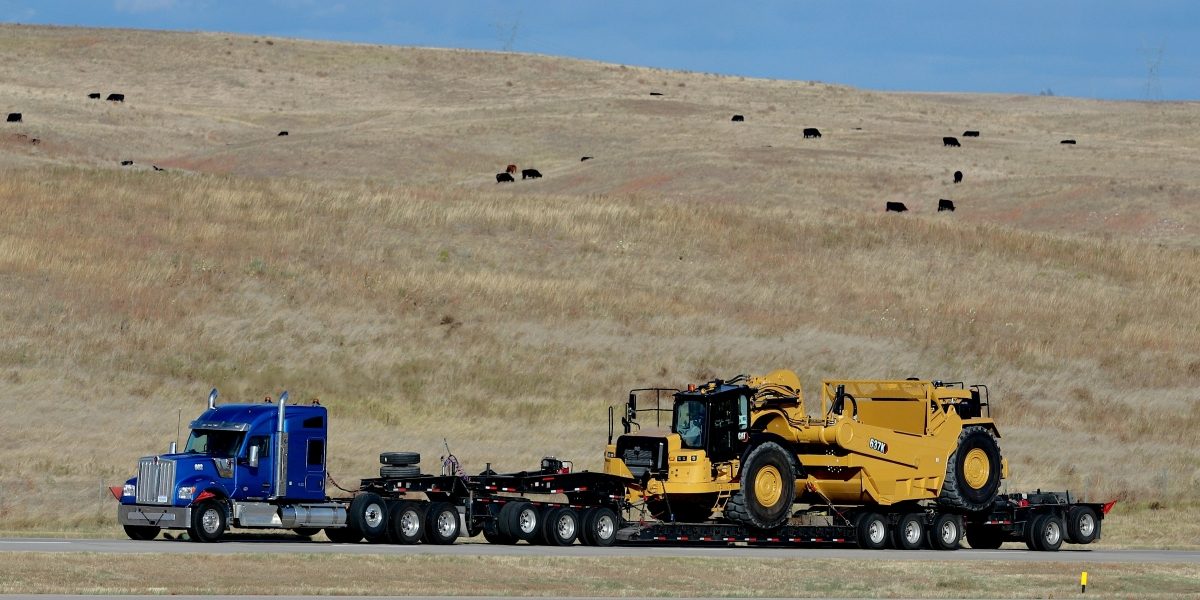As industrial growth accelerates and global projects become more complex, the need for heavy equipment continues to grow. However, heavy equipment logistics is a challenging task that requires careful planning, specialized packaging, and adherence to safety rules and procedures. This blog explores the heavy equipment transport system, the process involved, its limitations, and key steps businesses can take to ensure the safe shipping and arrival of their heavy cargo.
What Is Heavy Equipment Transport?
Heavy equipment transport, or heavy transportation, refers to the process of moving large, heavy, and unconventionally shaped items (such as machinery and industrial equipment) from one location to another. Given the nature of such cargo, transporting heavy equipment requires careful planning and specialized packaging. Some examples of heavy equipment include cranes, excavators, bulldozers, tractors, farming equipment, industrial machinery, and others.
To conduct heavy transportation, specialized vehicles and thorough planning are often required. The Overseas Project Cargo Association (OPCA) is one of the leading networks of project cargo freight forwarders. Its members are well-versed in transporting heavy cargo that cannot be loaded onto standard vehicles due to its shape, size, or weight requirements.
Types of Vehicles Used for Heavy Equipment Hauling
Considering the size, weight, and shape parameters, hauling very heavy transport often necessitates the use of specific vehicles. These may include:
- Lowbed trailers
- Drop-deck trailers
- Multi-axle trailers
- Extendable trailers
- Modular hydraulic trailers
- Tilt trailers
The availability of multiple vehicle options for heavy equipment transport allows freight forwarders to tailor their transportation plans based on the specific type of cargo involved.
How Does the Heavy Equipment Transport Process Work?
One of the key reasons to consider partnering with an OPCA member for heavy equipment transport is their expertise in staying up-to-date with permits, documentation, and compliance rules for the smooth transport of heavy machinery. This helps reduce the likelihood of fines, delays, and safety issues.
The required documentation typically includes a notarized bill of sale, along with details of the cargo, such as dimensions and specifications. Additionally, a power of attorney form and identification for both the shipper and receiver are often needed. Customs documentation and specific permits must also be prepared.
Compared to other types of freight transportation processes, very heavy transport often requires more extensive oversight and meticulous planning. Below is a breakdown of the heavy equipment transport process:
Choosing a Freight Forwarder: This is a crucial step in the process. The selection of an experienced freight provider can significantly impact the success of the heavy equipment transport process. OPCA has an extensive network of project cargo freight providers who are recognized for their expertise. OPCA members manage all types of freight transport and are particularly well-equipped for heavy equipment logistics.
Initial Assessment: During the initial assessment, the freight forwarder receives details about the type of cargo being transported.
Customized Plan: The initial assessment leads to the creation of a detailed and tailored plan that includes elements such as the type of specialized vehicle, route planning, permits, and other handling requirements.
Once the initial assessment is complete and a customized plan is in place, the OPCA freight forwarder selects the most appropriate transport vehicle. Choosing the right transport is important for ensuring safety, stability, and adherence to recognized industry standards. After selecting the proper transport, detailed preparation is needed. This includes actions such as cleaning the equipment, draining fluids and oils, removing detachable parts, securing loose components, and providing protection for fragile items. This preparation helps minimize the risk of damage and ensures safety during transportation.
Loading and Securing Cargo: After preparation, the cargo is loaded onto the selected freight transport using specialized equipment like cranes, winches, and hydraulic lifts. It is then secured with custom straps and covers to ensure stability and reduce the chance of accidents.
Cargo Tracking: By partnering with an OPCA freight forwarder, businesses gain access to real-time tracking and updates for both domestic and international shipments of heavy equipment cargo.
Arrival and Customs at Destination Port: Once the cargo reaches its destination port, it is typically handled by the OPCA member freight forwarder in the destination country. This partner is responsible for managing customs clearance and coordinating the final delivery.
Delivery: After the cargo clears customs, it is inspected for any potential damage. If no issues are found, the cargo is delivered to the designated address or to a storage warehouse.
Key Safety Considerations in Heavy Hauling
Ensuring safe heavy equipment logistics involves following all relevant safety rules, making it crucial to choose an experienced freight provider. Proper loading and securing of cargo are essential. The use of well-maintained specialized vehicles and experienced drivers adds a level of safety, particularly in land freight. Securing all permits and completing customs documentation are also vital. However, safety planning goes beyond these steps. In some cases, pilot vehicles are used for land freight, providing an additional layer of security.
Weather and road conditions should also be carefully monitored to reduce risks. Real-time GPS tracking and direct communication help facilitate smooth operations. Strict safety measures during on-site loading and unloading further contribute to reducing risks and improving the efficiency of the transport process.
These safety considerations not only help ensure the safe arrival of equipment but are also important for the protection of crew members, dock workers, drivers, and shipping personnel involved in the transportation process.
Heavy Equipment Transport Companies in the OPCA Directory
Selecting a heavy equipment transport provider is one of the more important steps in managing heavy equipment logistics. Partnering with an OPCA member can simplify what is often an extensive research and vetting process.
OPCA stands for the “Overseas Project Cargo Association.” It is home to a global network of experienced project cargo freight forwarders. OPCA members specialize in transporting bulky machinery, industrial parts, equipment, and large cargo around the world safely and effectively. OPCA members are involved in all kinds of freight transport, including land, sea, air, and rail. By choosing an OPCA member, businesses can compare quotes from multiple freight forwarders, explore a variety of transport solutions, and benefit from valuable support in obtaining permits and other necessary documentation.

















